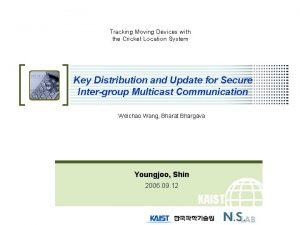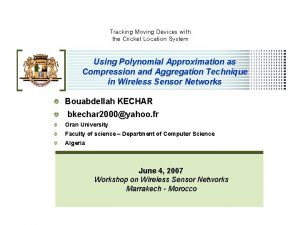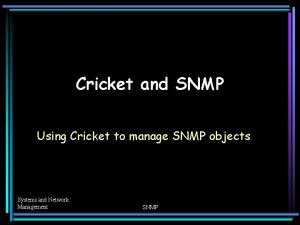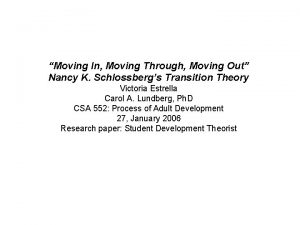Tracking Moving Devices with the Cricket Location System























- Slides: 23

Tracking Moving Devices with the Cricket Location System Medium Access Control with Coordinated Adaptive Sleeping for Wireless Sensor Network Wei Ye, John Heidemann, Deborah Estrin 2003 IEEE/ACM TRANSACTIONS ON NETWORKING Hong Nan-Kyoung Network & Security LAB at KAIST 2006. 09. 06 KAIST

Contents Introduction MAC attributes Sensor-MAC (S-MAC) overview S-MAC major components Periodic listen and sleep Collision avoidance Coordinated Sleeping Overhearing avoidance Massage passing Implementation Experiments Conclusion S-MAC 2

Introduction Where is the medium access control (MAC) Application layer A sublayer of the Link layer Transport layer Directly controls the radio Network layer Link/MAC layer Only cares about its neighborhood Physical layer < Network model from Internet> The role of MAC Controls when and how each node can transmit Why do we need MAC? Shared medium Same frequency band interfere with each other – collisions S-MAC 3

MAC attributes Characteristics of wireless sensor network (WSN) Battery powered Large number of nodes Sensor-triggered bursty traffic Topology and density change In-network data processing Nodes for a common task WSN can often tolerate some delay Primary attributes Energe-efficiency, scalability, adaptability Secondary attributes Latency, fairness, throughput S-MAC 4

S-MAC overview Goal Reducing energe consumption in WSN Major sources of energy waste Collision Overhearing Control packet overhead Long idle listening Tradeoffs Latency & Fairness Energy S-MAC 5

S-MAC major components Collision avoidance Coordinated Sleeping Periodic listen and sleep Schedule Synchronization Adaptive Listening Overhearing avoidance Massage passing S-MAC 6

Collision avoidance S-MAC is based on contention Collision-Avoidance Strategy ~= 802. 11 ad hoc mode RTS/CTS for hidden terminal problem Physical carrier sense Virtual carrier sense: network allocation vector (NAV) Randomized backoff time Sender Receiver RTS DATA CTS ACK NAV (based on RTS) Other Sensors Contend for medium access defer access NAV (based on CTS) S-MAC 7

Coordinated Sleeping Problem: Idle listening consumes significant energy Solution: Periodic listen and sleep listen sleep Frame Turn off radio when sleeping Reduce duty cycle to ~ 10% Latency Energy duty cycle = listen interval / frame length Receiver for SYNC CS for RTS for CTS CS Send data Sender Tx SYNC Sleep Tx RTS Got CTS S-MAC 8

Coordinated Sleeping Schedules can differ Node 1 Node 2 listen sleep listen sleep Prefer neighboring nodes have same schedule Easy broadcast & low control overhead Schedule 1 Schedule 2 S-MAC Border nodes : two schedules or broadcast twice 9

Coordinated Sleeping Schedule Synchronization New node tries to follow an existing schedule Remember neighbors’ schedules To know when to send to them Broadcasts its schedule using SYNC pkt Re-sync when receiving a schedule update Periodic neighbor discovery Keep awake in a full sync interval Syncronization period (SP) Listen SP Sleep SP SP Frame S-MAC 10

Coordinated Sleeping Adaptive listening Reduce multi-hop latency due to periodic sleep Wake up for a short period of time at end of each transmission 2 1 3 4 RTS CTS listen t 1 listen t 2 Reduce latency by at least half S-MAC 11

Latency Analysis N hop total delay Dn = D 1 + D 2 +. . . + D 10 Delay = Carrier sense (tcs) + Transmission (ttx) + Sleep (ts) MAC without sleeping E[D(n)] = N(tcs + ttx) S-MAC without adaptive listening E[D(n)] = NTf – Tf /2 + tcs + ttx S-MAC with adaptive listening E[D(n)] = NTf /2 –Tf/2 + 2 tcs + 2 ttx S-MAC 12

Overhearing avoidance Problem: Receive packets destined to others Solution: Sleep when neighbors talk Use in-channel signaling Who should sleep? All immediate neighbors of sender and receiver How long to sleep? The duration field in each packet informs other nodes the sleep interval Use NAV to schedule the sleep timer E C A B S-MAC D F 13

Massage passing Problem: Sensor net in-network processing requires entire message Solution: Don’t interleave different messages Sending a long message? Fragmented & sent in burst RTS/CTS/ACK –duration fields Fragment-level error recovery — ACK Extend Tx time and re-transmit immediately Other nodes sleep for whole message time Sender Receiver RTS FRAG 1 CTS FRAG-N ACK NAV (based on RTS) Other Sensors defer access NAV (based on CTS) S-MAC 14

Massage passing Difference between 802. 11 & S-MAC Medium is reserved upfront for the whole transmission in S-MAC Fairness Energy & Msg-level latency S-MAC 15

Implementation on Testbed Nodes Platform Mica Motes (UC Berkeley) Tiny. OS: event-driven Configurable S-MAC options Low duty cycle with adaptive listen Low duty cycle without adaptive listen Fully active mode (no periodic sleeping) Layered model on Motes MAC layer: S-MAC Physical layer Radio state control, Carrier sense S-MAC 16

Experimentation Two-hop network at different traffic load Source 1 Sink 1 Average energy consumption in the source nodes 1800 Source 2 Sink 2 Avoiding overhearing Effeciently transmitting long messages Periodic sleeping Energy consumption (m. J) 1600 1400 802. 11 -like protocol without sleep 1200 1000 S-MAC without periodic sleep 800 600 400 S-MAC with periodic sleep 200 0 2 4 6 8 10 Message inter-arrival period (second) <Mean energy consumption on radios in each source node> S-MAC 17

Experimentation Ten-hop linear network at different traffic load Energy consumption (J) 30 25 No sleep cycles 20 15 10 10% duty cycle without adaptive listen 5 0 10% duty cycle with adaptive listen 0 2 4 6 8 Message inter-arrival period (S) S-MAC 10 <Aggregate energy consumption on radios in the entire ten-hop network using three S-MAC modes> 18

Experimentation Adaptive listen significantly reduces latency causes by periodic sleeping 12 10 Average message latency (S) 12 10% duty cycle without adaptive listen 8 6 4 10% duty cycle with adaptive listen 2 0 0 No sleep cycles 2 4 6 8 10 6 4 10% duty cycle with adaptive listen 2 0 0 10 Number of hops 10% duty cycle without adaptive listen 8 No sleep cycles 2 4 6 8 10 Number of hops <Mean latency under lowest traffic load> <Mean latency under highest traffic load> S-MAC 19

Experimentation Adaptive listen significantly increases throughput Using less time to pass the same amount of data 220 Effective data throughput (Byte/S) 200 180 No sleep cycles 160 140 120 10% duty cycle with adaptive listen 80 60 40 10% duty cycle without adaptive listen 20 0 0 2 4 6 8 10 Number of hops <Effective data throughput under highest traffic load> S-MAC 20

Experimentation Periodic sleeping provides excellent performance at light traffic load Energy-time product per byte (J*S/byte) With adaptive listening, S-MAC achieves about the same performance as nosleep mode at heavy load 3 2. 5 No sleep cycles 2 1. 5 1 10% duty cycle without adaptive listen 0. 5 0 0 2 4 10% duty cycle with adaptive listen 6 8 10 Message inter-arrival period (S) <Energy-time cost on passing 1 -byte data from source to sink> S-MAC 21

Conclusion S-MAC Medium access control protocol for wireless sensor networks Main goal : Energy efficiency Components Periodic sleeping Low-duty-cycle operation + Overhearing avoidance + Message passing Periodic sleeping increase latency and reduces throughput + Adaptive listening S-MAC 22

S-MAC 23
 On the grasshopper and the cricket literary devices
On the grasshopper and the cricket literary devices A cross country skier moves from location a
A cross country skier moves from location a Market area plant strategy
Market area plant strategy Hát kết hợp bộ gõ cơ thể
Hát kết hợp bộ gõ cơ thể Bổ thể
Bổ thể Tỉ lệ cơ thể trẻ em
Tỉ lệ cơ thể trẻ em Gấu đi như thế nào
Gấu đi như thế nào Chụp phim tư thế worms-breton
Chụp phim tư thế worms-breton Bài hát chúa yêu trần thế alleluia
Bài hát chúa yêu trần thế alleluia Các môn thể thao bắt đầu bằng tiếng chạy
Các môn thể thao bắt đầu bằng tiếng chạy Thế nào là hệ số cao nhất
Thế nào là hệ số cao nhất Các châu lục và đại dương trên thế giới
Các châu lục và đại dương trên thế giới Công thức tính độ biến thiên đông lượng
Công thức tính độ biến thiên đông lượng Trời xanh đây là của chúng ta thể thơ
Trời xanh đây là của chúng ta thể thơ Mật thư anh em như thể tay chân
Mật thư anh em như thể tay chân 101012 bằng
101012 bằng Phản ứng thế ankan
Phản ứng thế ankan Các châu lục và đại dương trên thế giới
Các châu lục và đại dương trên thế giới Thơ thất ngôn tứ tuyệt đường luật
Thơ thất ngôn tứ tuyệt đường luật Quá trình desamine hóa có thể tạo ra
Quá trình desamine hóa có thể tạo ra Một số thể thơ truyền thống
Một số thể thơ truyền thống Cái miệng nó xinh thế
Cái miệng nó xinh thế Vẽ hình chiếu vuông góc của vật thể sau
Vẽ hình chiếu vuông góc của vật thể sau












































